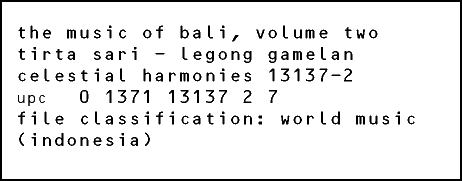 |
|||||||||||||||||||||||||||||||||||||||||||||
 
the projectThis the second of a three volume series featuring Balinese music and is part of a larger body of music from the largest Islamic country in the world, Indonesia. Gamelan gong kebyar was first heard in 1914 in north Bali and quickly caught on in the south. Kebyar music is characterized by a vibrant dynamic quality that is produced through strong rhythmic accents and sudden shifts in dynamics, tempo, and mood. Gamelan gong kebyar incorporated a new form of dance simply called Kebyar, in which the dancer's changing expressions and postures mirror the shifting character of the music. Gamelan gong kebyar continues to be extraordinarily popular, and has become a favorite medium for many of the island's greatest creative artists over the past several decades. Tirta Sari combines the gamelan with the traditional and famous Legong (track 3), danced by pre–adolescent girls who usually begin their training at eight or nine years old, and retire as teenagers. Although Balinese dance is characterized by many rapid movements—facial and those of the hands and fingers—the most important element is the innocent, abstract and even etheral quality such as in the dance of the divine nymphs, which can only be rendered purely by very young dancers. Drumming patterns are closely linked to specific movements of the dancer. The dancer delivers visual cues to the drummer, who responds by conveying sound cues to the musicians. As Balinese performers often say, the music and dance must be completely married in spirit to present the best performance.
the artistsIn keeping with producer David
Parsons' unparalleled site recording style recapturing lost arts
and creating new, this second volume of the Balinese series was recorded
in the Pura Gunung Sari Temple at Peliatan, Bali. Peliatan, a small
village south of Ubud, is famous for its Legong traditions.
Gamelan refers to an ensemble of instruments in Java and Bali which is comprised primarily of bronze gongs and metallophones tuned so that intervals of a scale conform to certain tuning models. The tuning for the gamelan used by Tirta Sari is based on the gamelan Semar Pegulingan, an ensemble that, in its original form, utilized the seven–tone pelog tuning system common to Bali and Java. Later, the Tirta Sari ensemble was modified (by adding instruments and changing the configuration and range of the keys and kettle-gongs on the existing instruments), to make it more similar to the gamelan gong kebyar, the most popular type of gamelan in present–day Bali. By taking elements from both types of gamelan, Tirta Sari has been able to play a wider variety of musical styles and repertiore, as well as dances. The principal musicians of the Tirta Sari ensemble are Tjok Alit Hendrawan, Anak Agung Oka Dalam, Wayan Kopi, Ketut Madra, Tjok Bagus and Wayan Subrata. tracklist
Celestial Harmonies' catalogue of Indonesian recordings include:
|
|||||||||||||||||||||||||||||||||||||||||||||
|
|
|||||||||||||||||||||||||||||||||||||||||||||
 |



